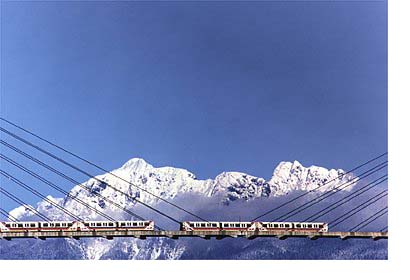Background
[Main]
[Outline]
[Methodology]
[Analysis]
[Problems]
[Conclusion]
 Within the academic literature on public transit, there are two different opinions on the way municipalities should invest their money in to provide the best service for their citizens. On the one hand, fixed rail systems are preferred for their speed and for the certainly such substantial investments create in the minds of the commuters . On the other hand, expanded bus services provide a much broader service for a substantially smaller investment. With the contention in Vancouver over the expansion of the Skytrain down the Broadway corridor, these two views have been expressed time and time again in the media. I, however, have not dealt with this issue at all within this project. Instead, I continually ask myself why Translink is building another east-west fixed rail system when the obviously more appropriate choice would be to build a north-south line that ultimately links to the airport. I have therefore taken on the task of determining the best route this north-south line should take.
Within the academic literature on public transit, there are two different opinions on the way municipalities should invest their money in to provide the best service for their citizens. On the one hand, fixed rail systems are preferred for their speed and for the certainly such substantial investments create in the minds of the commuters . On the other hand, expanded bus services provide a much broader service for a substantially smaller investment. With the contention in Vancouver over the expansion of the Skytrain down the Broadway corridor, these two views have been expressed time and time again in the media. I, however, have not dealt with this issue at all within this project. Instead, I continually ask myself why Translink is building another east-west fixed rail system when the obviously more appropriate choice would be to build a north-south line that ultimately links to the airport. I have therefore taken on the task of determining the best route this north-south line should take.
Berwick and Cervaro in their book, Transit Villages in the 21st Century (1997 McGraw Hill Press) make it clear that mass transit systems require mass or density if they are to be successful. With this in mind, I have used population density in Vancouver to create a raster surface from which I determined a best route for a skytrain rail to follow that will pass through the most densely populated areas of Vancouver. (I'm sure all the people who have the rail running through their backyard will be thankful!.)
 Within the academic literature on public transit, there are two different opinions on the way municipalities should invest their money in to provide the best service for their citizens. On the one hand, fixed rail systems are preferred for their speed and for the certainly such substantial investments create in the minds of the commuters . On the other hand, expanded bus services provide a much broader service for a substantially smaller investment. With the contention in Vancouver over the expansion of the Skytrain down the Broadway corridor, these two views have been expressed time and time again in the media. I, however, have not dealt with this issue at all within this project. Instead, I continually ask myself why Translink is building another east-west fixed rail system when the obviously more appropriate choice would be to build a north-south line that ultimately links to the airport. I have therefore taken on the task of determining the best route this north-south line should take.
Within the academic literature on public transit, there are two different opinions on the way municipalities should invest their money in to provide the best service for their citizens. On the one hand, fixed rail systems are preferred for their speed and for the certainly such substantial investments create in the minds of the commuters . On the other hand, expanded bus services provide a much broader service for a substantially smaller investment. With the contention in Vancouver over the expansion of the Skytrain down the Broadway corridor, these two views have been expressed time and time again in the media. I, however, have not dealt with this issue at all within this project. Instead, I continually ask myself why Translink is building another east-west fixed rail system when the obviously more appropriate choice would be to build a north-south line that ultimately links to the airport. I have therefore taken on the task of determining the best route this north-south line should take.